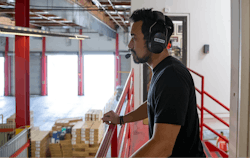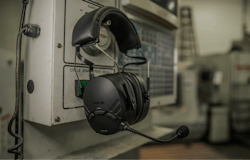Sound Communication Strategies Improve Workplace Safety
Every successful business is a product of good communication among its team members. That’s especially true in industrial settings, where a lack of communication can lead to worker injuries, equipment issues, and even plant shutdowns. However, safety managers may not be familiar with the many ways that sound communication strategies can set the tone for improved workplace safety and productivity.
While plant processes and Industry 4.0 have advanced with technology, so have the communication tools. This article addresses those advancements and clarifies how good communication processes paired with recent technology improvements may reduce worker injuries, increase efficiency and productivity, as well as better engage team members.
Clearing up Risk
Managers need to be aware of the risks when a cohesive communication plan is lacking. When workers aren’t kept up to date on processes and equipment safety, it may increase the risk of incidents. When a hazard is encountered, workers need a means to communicate with other team members.
One of the biggest reasons that communication fails is lack of employee engagement. When workers don’t feel part of a team, they are less likely to do their best. Having a clear communication plan—and a supporting communications technology—ensures that everybody feels connected and aware of what’s going on in the workplace. The good news is that managers can be on the road to clear communication in four simple steps: communicate efficiently, in real time, safely, and with the right people.
Communicate Efficiently
An efficient option for communicating with employees is SMS text messaging, which some companies use to notify employees of daily work information and special conditions, such as a pending snow storm. The communication goes primarily one way, for example, from the plant manager to employees. It is ideal for all-employee bulletins, but it is difficult to target just the workers on that night’s shift.
The two-way radios common in many industrial settings are another efficient means of worker communication. They allow workers to communicate with each other, but they do not connect to outside parties, who must have a message relayed by someone with a radio. The nature of FM band radio limits sound quality, and, because it is a public band, it is susceptible to chatter from driver radios at the loading dock and other radios outside the facility.
Some long-range wireless headsets (Figure 1) now use the bluetooth frequency band around 2.4 GHz. They have the advantage of high-definition sound and noise cancelling technology. Clarity is key to understanding. Two-way radios are half-duplex, which means that only one person can speak at a time. Sometimes this means getting only half of a message, which could compromise safety. In contrast, bluetooth and mesh headsets are full duplex, letting multiple people talk and listen at the same. Also, they are immune to the signal drops of Wi-Fi and cellular devices.
The environment should factor into considerations about which communications technology to use. Because of the ambient noise and physical distance found in many industrial settings, workers may shout, use hand signals, or read lips to communicate. This style of communication could become a safety issue if there is a misunderstanding. Of course, if workers are wearing face masks, then lip reading is impossible. Workers may seek out a quiet area to talk, but it may not be safe to walk away from the place where the work is being done.
SMS text works in all levels of ambient noise. Two-way radios allow workers to talk across distance and over noise, but usually the radios are hand-held, and workers may have trouble hearing. In critical situations, this could lead to safety incidents. Headsets using the latest sound technology make it easier for workers to hear each other.
Communicate in Real Time
When workers encounter a hazard, they need to communicate throughout the facility, to gain assistance or to warn others. Rather than post a handwritten sign or go in search of a supervisor, it is better to immediately report the situation via radio or wireless communication network. A bluetooth or mesh network provides intercom capability to every person wearing a headset, and via an adapter, it can also communicate with mobile phones—useful when an off-site manager or outsider such as a fire chief speaks directly to workers. A communications plan should include employee training, so that workers understand when real-time communication is necessary and when it is okay to wait.
Communicate Safely
Messages sent by SMS text require workers to look at their phones and use their hands, a distraction that could compromise safety, in the same way that distracted driving leads to highway accidents. Two-way radios let people keep their eyes on their work, although users must push the button to talk. In extreme cases, the time it takes to put down a tool and activate the talk button might not be fast enough to warn a coworker of a danger. In comparison, bluetooth and mesh headsets enable instant, hands-free communication.
Mesh headsets are available with ear-muff style hearing protection. Noise reduction ratings range from 21 to 26 decibels for standard headsets and 20 to 24 decibels for headsets mounted on hard hats. If workers depend on headsets for doing their jobs, then adoption of built-in hearing protection is assured.
Communicate with the Right Groups
Workers should be trained to know which system is appropriate for communicating a message, and who on that system should get the message, i.e., their department or the whole facility. For example, workers should have the ability to easily communicate with the maintenance team about a new hazard. Mesh technology offers multiple channels, so departments can talk privately on separate channels or communicate with all team members. The basic range of a mesh network is about a half mile, but each headset acts as a node, extending the range.
Tuning in to New Technologies
Bluetooth headsets connect to each other using an intercom protocol. These networks are limited to four workers, and are good for small work teams (Figure 2). Mesh headsets are similar, but each headset acts as a repeater, expanding the network to a virtually unlimited number of people. An adapter, usually worn on the belt, can connect a bluetooth headset to the more powerful mesh network. Other adapters can connect the network to two-way radios and smart phones.
Working in Harmony
Wireless headsets and two-way radios are affordable, but the cost adds up with the number of units. Safety managers can justify their cost on the basis of productivity. Alerting workers instantly about shipments arriving or production changes saves time, making teams more productive. The ability to reach workers with critical information clears up conflicting messages and avoids having to repeat information. In an IoT environment, any bluetooth-enabled PLC can be connected to the mesh network. Spoken alerts can supplement pillar lights, texts, and audible notifications, enabling workers to quickly respond to issues.
Many challenges to achieving a safe workplace can be met by delivering better communication. Utilizing the strategies outlined in this article, and having the right tools in place, managers can implement a communication plan that improves workplace safety and productivity.
Chris Clarke is an industrial communications consultant at Sena Industrial, a provider of bluetooth- and mesh-enabled headsets and communications solutions for industrial and outdoor worksite environments.
About the Author
Chris Clarke
Chris Clarke is an industrial communications consultant at Sena Industrial, a provider of bluetooth- and mesh-enabled headsets and communications solutions for industrial and outdoor worksite environments.


